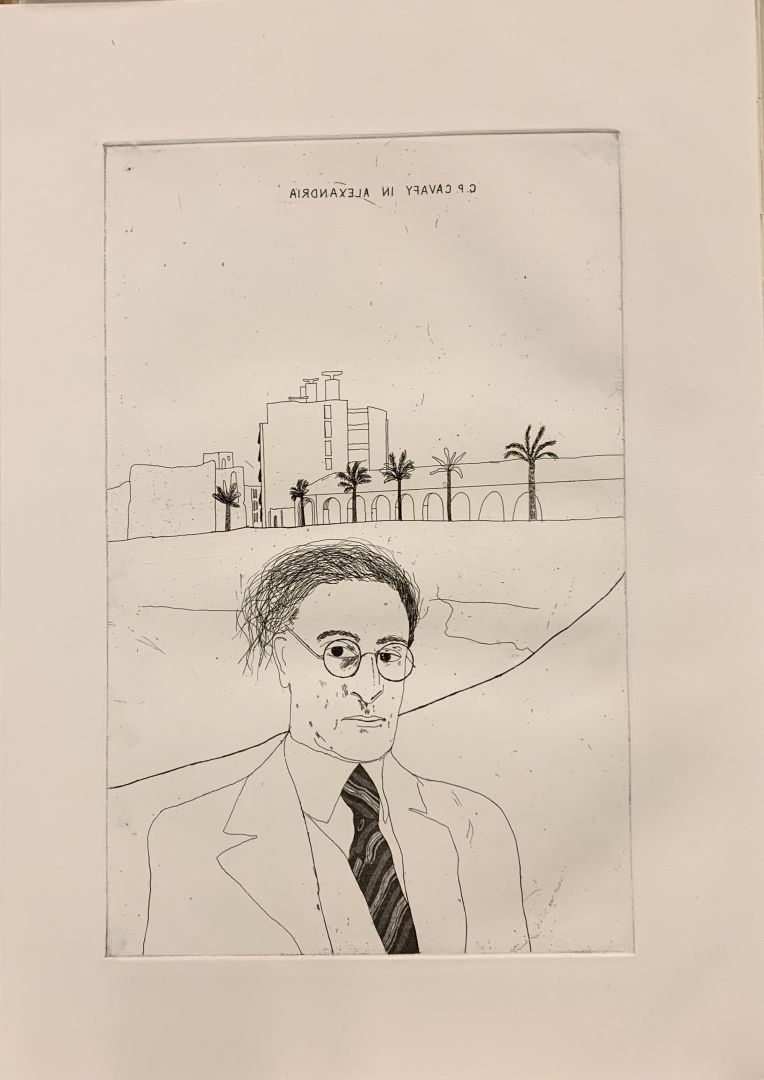Hockney, David) illus. FOURTEEN POEMS BY C.P. CAVAFY. S.47-59. Editions Electo, London, 1966. Folio (19 x 13 /14 inches, 484 x 385 mm.), cloth, slipcase, text and thirteen etchings. One of 250 copies from "Edition A," signed and numbered 26/500 on the Justification page (Edition A, numbered 1-250/500; Edition B, numbered 251-500/500. Edition A differs from Edition B in that it includes an extra plate, laid in and signed and dated "'66" by Hockney. Fine throughout, with no signs of wear and no defects. The loose plate has often been removed from the book at sold separately, and many copies from Editions A and B have been broken and the plates sold separately, so that despite the relatively large size of the publication, complete copies are now scarce. The total edition comprises "Edition A," 250 copies, numbered 1-250 plus 50 Artist's Proofs, all signed, with a signed etching laid into each of the 250 copies, but not into the Artist's Proofs, "Edition B," 250 copies, like Edition A, but without the laid-in etching, numbered 251-500, "Edition C," 50 sets of the etchings loose in portfolio numbered 1-50 of 75, each etching signed, "Edition D," 25 sets, plus 15 Artist's Proofs, 12 unsigned etchings and textd, numbered 51 to 75 of 75 and signed by Hockney on the back of the portfolio, "Edition E," 25 sets, plus 5 artist's proofs, comprising text, 12 unsigned etchings, and one signed etching, loose in portfolio, numbered I to XXV, and signed by Hockney. Each etching in each edition is stamped on its reverse with the edition of which it is a part. The total size of the edition, including the Artist's Proofs, is, therefore, 600."David Hockney first discovered the Greek poet C.P.Cavafy while a student at the Royal Colege of Art in the early nineteen sixties. In 1961 he produced two etchings (Kaisarion with all his Beauty; Mirror, Mirror on the Wall) and a painting (A Grand Procession of Dignitaries in the Semi-Egyptian Style ) inspired by Cavafy's poems. So when Paul Cornwall-Jones of Editions Alecto asked him to make a series of etchings relating to Cavafy in 1966 he agreed without hesitation. "The poems Hockney chose all related to Alexandria in Egypt with its barely concealed flavour of homosexual love, but Alexandria had become too spoilt since the poems were written in the nineteen twenties and so he travelled to Beirut for two weeks in order to make careful pen and ink drawings of the daily life of the city. On his return he created the etchings which vividly demonstrated his new fascination with observed reality after the more abstract imagery of the Rake?s Progress series of 1961-63.The Beirut drawings provided architectural settings for the two portraits of Cavafy as well as for To Remain (a dry cleaning shop) and the shop window of a tobacco store (a shop beneath an advertisement for HIS MASTER?S VOICE in English and Arabic). He Enquired After the Quality shows a man selling handkerchiefs to another man and is closely based on a drawing of a man selling bottles in the bazaar, which is inscribed by Hockney ?these should be handkerchiefs.? Hockney decided to concentrate on the homosexual poems and the rest of the series come from drawings of pairs of boys in his bedroom in Notting Hill Gate with the exception of In an Old Book and One Night, which are taken from male physique magazines.The Cavafy prints are not literal illustrations of the poems but are visualizations of their nostalgia for fleeting but memorable sexual encounters. Thefeeling of authenticity generated by the images is due ?to Hockney?s own personal experiences. They were instantly acclaimed. Edward Lucie-Smith spoke of their ?staggering virtuosity? and described them as ?not only the best work I have seen by the artist but probably the finest prints produced in England since the war.? The Arts Council made a film about the creation of the engravings entitled ?Love?s Presentation.? Peter Webb, 2001.Peter Webb is the author of Portrait of David Hockney (Chatto, 1988) and David Hockney, Grimm?s Fairy Tales (South Bank Center).
Follow us
Contact Us
ed@edpollackfinearts.com
Copyright © 2025 - Edward T. Pollack Fine Arts





